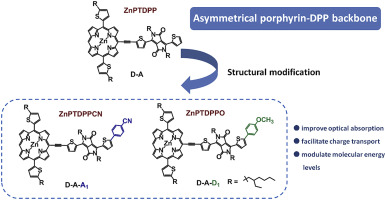Dyes and Pigments ( IF 4.1 ) Pub Date : 2020-01-17 , DOI: 10.1016/j.dyepig.2020.108211 Feiyue Cheng , Xiaodong He , Lunxiang Yin , Bao Xie , Yanqin Li

|
Three novel organic small molecules based on asymmetric porphyrin-diketopyrrolopyrrole (DPP) backbone, namely ZnPTDPP, ZnPTDPPCN and ZnPTDPPO, have been designed and synthesized for solution-processed organic solar cells (OSCs). The terminal units of 4-cyanophenyl and 4-methoxyphenyl were introduced into ZnPTDPPCN and ZnPTDPPO respectively, and the structural modification effects on photoelectric and photovoltaic performance were fully investigated. Depending on the characteristics of porphyrin and DPP, all three molecules possess narrow bandgaps of lower than 1.50 eV, showing excellent absorption properties. Structural modification of terminal groups can effectively regulate energy levels of ZnPTDPPCN and ZnPTDPPO. As expected, extended molecular structure from D-A type to D-A-A1 or D-A-D1 type, was conducive to enlarging the π-conjugation and affecting the push-pull effect of intramolecular electrons, thus affecting the photoelectric character of materials. Solution-processed OSCs employing these molecules as the donor materials and PC61BM as the acceptor material were fabricated. It was worth mentioning that devices based on materials ZnPTDPPCN and ZnPTDPPO achieved moderate power conversion efficiencies (PCEs) of 4.26% and 4.24%, respectively, while ZnPTDPP showed an inferior PCE of 1.46%. To our knowledge, the work based on asymmetric porphyrin-DPP backbone for solution-processed OSCs, is first reported. The work will provide valuable hints for rational design of asymmetric porphyrin-based donor materials.
中文翻译:

基于不对称卟啉-二酮吡咯并吡咯骨架的带隙小分子的设计与结构修饰
设计并合成了基于不对称卟啉-二酮基吡咯并吡咯(DPP)主链的三种新型有机小分子ZnPTDPP,ZnPTDPPCN和ZnPTDPPO,用于溶液处理有机太阳能电池(OSC)。将4-氰基苯基和4-甲氧基苯基的末端单元分别引入到ZnPTDPPCN和ZnPTDPPO中,并充分研究了结构改性对光电性能的影响。根据卟啉和DPP的特性,所有三个分子均具有低于1.50 eV的窄带隙,显示出优异的吸收性能。末端基团的结构修饰可以有效地调节ZnPTDPPCN和ZnPTDPPO。不出所料,分子结构从DA型扩展到DAA 1或DAD 1型,有利于扩大π共轭并影响分子内电子的推挽效应,从而影响材料的光电特性。制备了使用这些分子作为供体材料和PC 61 BM作为受体材料的溶液处理OSC 。值得一提的是,基于材料ZnPTDPPCN和ZnPTDPPO的器件分别实现了4.26%和4.24%的中等功率转换效率(PCE),而ZnPTDPP显示下等PCE为1.46%。据我们所知,首次报道了基于非对称卟啉-DPP骨架的溶液加工OSC的工作。这项工作将为基于不对称卟啉的供体材料的合理设计提供有价值的提示。









































 京公网安备 11010802027423号
京公网安备 11010802027423号